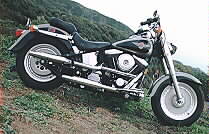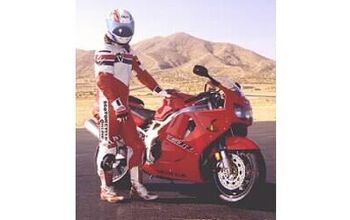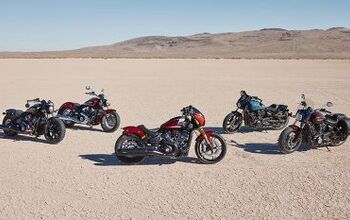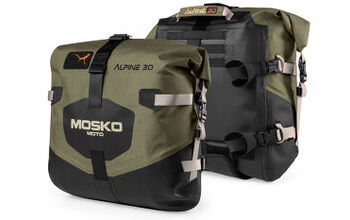Church of MO: Heavyweight Cruisers of 1996
We may not be allowed to bodyshame motorcycles or each other anymore with the F word, brethren, but 25 years ago we had not yet evolved into the empathetic creatures we are today. Besides, all these motorcycles’ heirs have only added avoirdupois over the years, which seems to be a trend with us humans, too, so why bring it up and risk being trampled? We blame the agricultural industrial complex. At least the least guilty party here is the only bike of the five that’s still in production; our specs indicate it’s gone from 631 pounds dry in 1996 to 671 today – which isn’t bad, as its engine has also gone from 1.3 liters to nearly 1.9. Let us now read, then ride out and find something to eat, amen.
—————————————————————————Heavyweight Cruisers, 1996
So we took a bunch of the biggest fellows we could find around the Redondo Beach offices of Motorcycle Online. Muscle Beach is just a five minute rollerblade away, but we didn’t need to go that far. Sure enough we found some substantial bodies, right here in the office. True, most of the strength in some of these specimens was concentrated in the arm muscles, exercised by constant lifting of hamburgers, cheeseburgers, 256 oz. mugs of Diet Coke and 12 oz. tins of Budweiser. Not to forget serious butt muscles, built by weeks of constant attention to the computer screen.Ah well, weight is weight. And after all, every cruiser motorcycle sells by image, not reality. These five heavyweight heroes (total tonnage, 1.5) plunked their substantial selves on the widely spreading seats of the our five heavyweight cruisers, one each from Harley-Davidson, Honda, Kawasaki, Suzuki, and Yamaha, then took off for a romantic cruise. To the burger joint, for a heart attack special. Over three burgers and two fluffy vegetarian things, we rated the bikes. Then we ate more burgers, and tested the suspension. Here’s what we found.
1: Kawasaki Vulcan 1500 Classic
Kawasaki’s and the world’s biggest cruiser is now available in three versions. From the original super-chunky Vulcan 1500 to the new Norman Rockwell-styled Vulcan 1500 Classic. Every year brings cruisers closer to the American original, and the Vulcan Classic is the closest yet, in looks at least. What is different from the real McCoy is the twin-shock rear end, shaft drive and the smooth performance.It’s taken some reworking to make this cruiser so smooth. Kawasaki’s engineers retained the four-speed transmission from the original Vulcan, but upped the gear ratio for the top three. Now, although you wouldn’t know it from the tachometer (especially since there is no tach), the engine loafs over at a low 2,500 rpm at 60mph. At this point in the engine’s power curve, vibration is minimal. Yet torque is there in plenty, thanks again to Kawasaki’s re-engineering of the big motor’s power curve.
Swinging a leg over the well-shaped saddle, the rider’s first impression is of size. The gas tank may only hold a teacupful over four gallons, but it feels like a 55 gallon drum between your knees. Substantial is the word. The handlebars, too, are high, wide, and buckhorned. Seat height is low enough that almost anyone can feel in control, instantly. Despite the huge size, manageability is good. The bike has good balance and feel, and can be hustled through corners at a reasonable pace. When something does touch down, it’s usually a footboard first. The brakes are confidence-inspiring, and well up to stopping this wide load. Suspension is a problem on a long, low bike, and the Kawasaki’s twin shocks are wooden and unresponsive, until you put even more weight, in the shape of a passenger, on them. Then they start to smooth out the bumps more.
What you need on the Kawasaki to appreciate the control placement, is an open face helmet. Most of us wussies feel naked without the protection of a full face, but the tank-mounted speedometer and all idiot lights are invisible in front of the protective chinbar on a full face lid. This malady is common on cruisers, and since only the Fat Boy has self-canceling turn signals, flashers left on was the most common symptom of the lack of feedback. On the positive side, moving the gadgets to the tank did give enough room for Kawasaki to plant an effective fuel gauge under the speedo, and the view of the uncluttered triple clamps and clasically shaped headlamp shell is elegant in the extreme.
If you like chrome, you’ll love the Vulcan. Acres of chrome plate cover the wide forks, the huge headlamp, and both air cleaners. (There’s one of the round chrome pieces on each side, although only one 40mm carburetor sits between the Vee. Style wins out over function, yet again.)
2: Harley-Davidson Fat Boy
It’s the most expensive in the test (especially since few Harley buyers ever pay less than retail, most pay lots more), it’s the most primitive to ride, and it shakes like an overloaded laundromat dryer, but there’s still something about a Harley that nobody else can clone, no matter how close they come. And since cruisers are style more than substance, the Fat Boy couldn’t possibly place any lower than second in this comparo. It has more style in one tank badge than most manufacturers print in their whole brochure.
That name on the tank means more to many people than any feature (or lack of them) that the Harley possesses. To be sure, the rigid mount 1340cc engine transmits a higher level of vibration to the rider than any of the other cruisers in this class, and the hand and foot controls lack the silky-smooth operation of the others. To some people, that’s a plus. If God had created motorcycles for sissies, they say, he would have given them four wheels and windshield wipers.More importantly, to our bunch of overweight weenies anyway, is the power level, which is on the low side. There may well be a stump-pulling, 80 inch V-twin under those svelte silver tanks, but modern pollution patrols and emissions tests have emasculated it. You can get serious power out of a Harley big twin: It takes about $1000 to get another 15-20 horsepower out of it.
Handling, however, is good. The rigid mount motor and disc wheels contribute to the absolutely solid feel of this machine, and compared to some of the knuckle-draggers in this test, ground clearance is ample. It takes a fairly serious effort into a corner before draggage occurs. The single front disc lacks the authority of some of the other machines, unsurprisingly, given the Harley’s second-highest weight of the test (only the Royal Star is heavier), but give it a good hard yank, and you’ll stop in plenty of time for breakfast.
More important than performance to many riders is the seat height. Here, the Fat Boy is unbeatable. The sub-26 inch seat height means even your grandmother could swing a leg over with ease. You’ll have to use Harley’s padlock style steering lock, secured with an ace key, to keep her from stealing away on the Fat Boy, since the ignition key is a simple, tank mounted switch. Or should we say tanks, because there are two. Two gas tanks means twin gas tank filler caps. Both have to be removed to fill the tanks (unless you want to wait an awful long time for the gas to drain through via the petcock hose), but each cap is threaded differently, so they cannot be misplaced. Things are different on a Harley.
3: Suzuki 1400 Intruder:
One of the longest in the teeth of the cruiser steeds, the Suzuki 1400 Intruder has been produced for the best part of a decade, with few apparent changes to the mix. The 1400cc twin was a sensation when launched: Here was a manufacturer that wanted to make a bigger bike to outgun Harley. Now, ten years later the 1400 seems small against the competition, an impression confirmed by the numbers. It is the smallest, lightest and narrowest of this blatantly corpulent bunch, and the easiest by far on the wallet. It’s the bargain of the bunch. Go to a Harley or a Yamaha dealer, pay full price and specify a handful of add-on extras, and you could easily part with twice the price of an Intruder, and you’d get a bike that was heavier, slower, and didn’t handle as well.But aren’t we missing the point here? The Intruder just doesn’t exude the kind of style our two higher-placed cruisers command. The smaller size of the ‘zuki is accentuated by the narrow bars: stepping off one of the other behemoths, your hands extend forward without meeting the grips, because they seem so close together.
Ergonomics are not helped by the position of the tank, the wedge-shaped rear of which ends just above the rider’s knees. The other bikes have substantial metal gas tanks to lean the knees against: the Suzuki’s lack of such a credential makes it feel more like a Harley Sportster than a big twin. And while we’re into off-test comparisons, the paint scheme that does so much to narrow the tank comes straight off a 1970s era Triumph, with scalloped cream flashes blending into pinstripes.Odd that Suzuki would try to reduce the apparent size of the bike with optical tricks like this, when everyone else is adding pounds faster than a Georgian powerlifter. Get on the gas, though, and the lack of weight means the bike will take off fast. It’s got great throttle and roll-on response, just like a real V-twin should (helped by its low weight, of course). At the traffic light Grands Prix, its the Suzuki that will always come out in front. At constant speed on the freeway, though, the carburetion feels on the lean side, and this lean surge (familiar to riders of mid-eighties bikes) is annoying. It feels like the bike is constantly just about to run out of gas. Cruising around town, on a constantly changing throttle, and the feel is not discernible. You can just see the grin on the rider’s face, as he passes bikes that cost twice as much.
More by John Burns



































Comments
Join the conversation
FYI: no one here says “tins of Budweiser”...
can or bottle (or draft/“draught”), m8
cheers
Yeah, and then came the Rocket III.